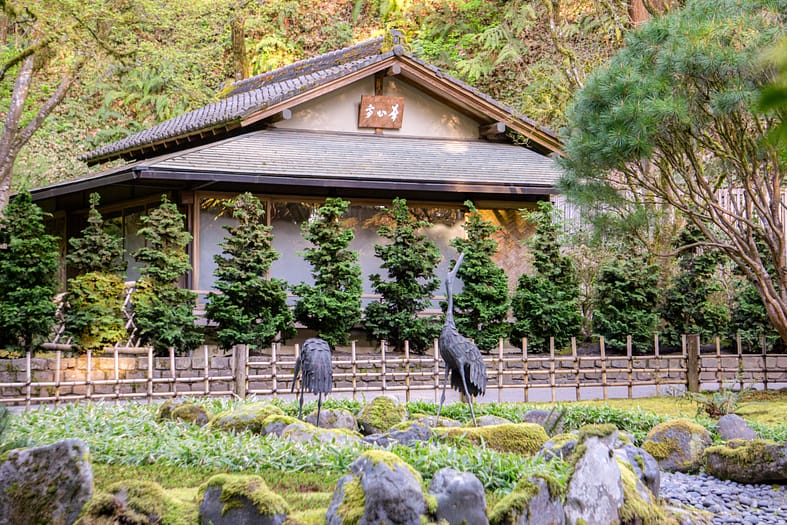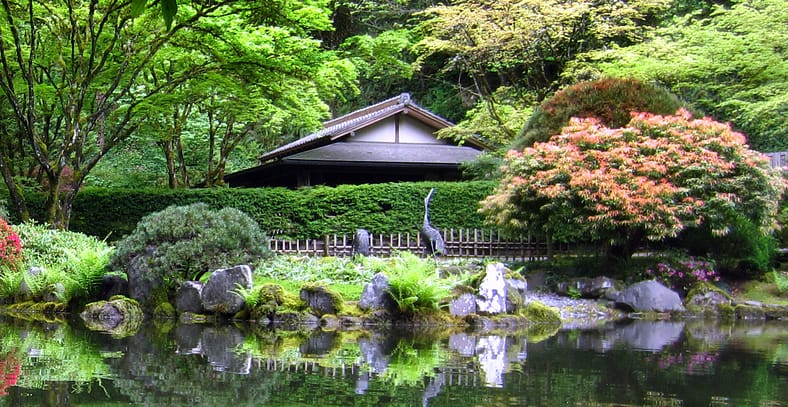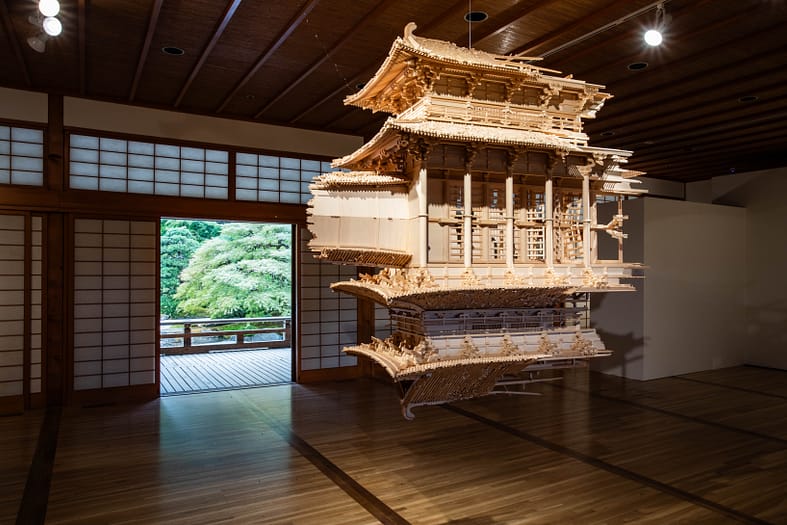
Bringing the Mountains to the Tea Garden
In March, the Garden Department of Portland Japanese Garden and its leader, Garden Curator Hugo Torii, engaged in a project to improve the Tea Garden. The space is a beautiful depiction of a style connected to Chado (Tea Ceremony), a deeply meaningful practice that Murata Shuko (1423-1502) is credited as having founded; one that was heightened by tea master Takeno Joo (1502-1555) and his pupil, the individual considered to be the greatest tea master, Sen no Rikyu (1522-1591). However, its outer periphery of hemlock hedges had been facing continual decline. “Unfortunately, the hemlock was experiencing root problems and fungal issues and the area had some problems with its drainage,” Torii shared.

After the hemlock was removed and the drainage improved, the space was filled with nearly 20 new hinoki, a cypress native to Japan that has been known to have been a part of Japanese garden design since the nation’s Heian period (794-1185). While the work to replace the hemlock was initiated at the suggestion of the gardeners he oversees, Torii ultimately determined what plant would replace it. “There were several elements to consider,” Torii pointed out. “In addition to making sure we would choose a plant suitable for the aesthetics and authenticity of our Tea Garden, we were limited by what was available in the market and what’s best for the environment. After considering some other plants, we went with hinoki. It has a dark and rich green color and excellent texture. It also works well in the Tea Garden because it helps provide the space with a more mountainous aesthetic. Historically, tea gardens have been designed to resemble mountain hermitages.”

“This particular hinoki, hinoki chabohiba, can be pruned and shaped in many different ways,” Torii noted. One only has to look further into the Tea Garden past the hedges to find a taller version of the plant, in the innermost section of the space, next to the Oribe lantern and tsukubai (water basin). “It will likely take several years for the hedges to start to come into a more ideal form, but our plan is to show how different pruning styles can give a different presentation and feel of the same trees. This is a long-term project, so the gardeners will have to work to make sure they have a shared vision and the skills to incrementally develop the hedges to our ideal style.”
Another notable change to the Tea Garden was the removal of a weeping Japanese maple tree near the Kashintei Tea House, which was escorted to its new home on the western edge of the Flat Garden across from the Membership Center. “It was too beautiful,” Torii noted.

Tea gardens do not typically feature specimen trees, plants that catch and focus the eye for us to look inwards rather than outwards. “[A tea garden] must look natural so as to be in harmony with the spirit of Tea Ceremony and conducive to a meditative frame of mind,” the Garden’s original designer, Professor Takuma Tono of Tokyo Agricultural University wrote in his 1958 book, A Secret of Japanese Gardens. “Once in the garden, one may feel detached from the world and away from the hustle and bustle of life. A rustic looking lantern, water basin, or trees and plants are important features.”
Torii noted that more changes may come to the Tea Garden over the next few years, contemplating making adjustments to its entry and possibly adding additional areas for people to sit and enjoy the serenity of the space. He also would like to eventually add more trees to give the space a more intimate feeling.
“Ultimately, I’m very proud of our gardeners and how they worked together on this,” Torii concluded. “They came up with the plan to replace the hemlock, install improved drainage, and to place the weeping Japanese maple in a part of the Garden that suits it better. I hope to continue to empower them as they engage in kaizen [continuous improvement] throughout our landscape while holding its essence of authenticity.”
More About Hinoki

Hinoki has been a deeply important tree throughout Japan’s history and, alongside cryptomeria, is one of the most valued conifers one might see in a Japanese garden. Its wood has been used for buildings of the Ise Shrine, a sacred Shinto site in Mie Prefecture and Horyu-ji, a Nara Prefecture Buddhist temple that is one of the oldest wooden structures in Japan. Aside from its contributions to spiritually significant sites, recent research has associated the cypress’ essential oils with feelings of relaxation—one can find hinoki oils used in many cosmetics and incense. In fact, Portland Japanese Garden’s Gift Shop sells bags containing aromatic hinoki wood that can be placed in baths and hot tubs.

Hinoki is also planted near the new Membership Center in the heart of the Garden, adjacent to the wisteria arbor. Hinoki wood can be found throughout Portland Japanese Garden. It constitutes parts of the Antique Gate at the foot of the hill in the Entry Garden and the Nezu Gate that people pass through when exploring the historical garden spaces. It has also been a material used by artists whose works have been featured in the Garden, including Japan Institute Artist-in-Residence Takahiro Iwasaki’s Reflection Model (Rashomon), a large-scale architectural model featured in the organization’s 2023 exhibition, Nature of Perception and the noh-men (masks used in Noh theater) of Ohtsuki Kokun featured in the 2017 show, Mirrors of the Mind.